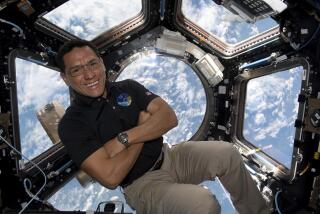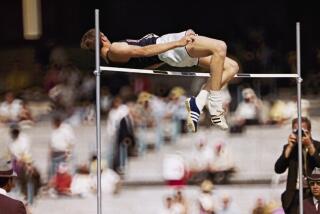Balloonist Finally Makes It Around the World
After failing five times and nearly losing his life in the process, American adventurer Steve Fossett on Tuesday became the first person to fly around the world solo in a hot-air balloon--and when he succeeded, he had to celebrate alone.
After spending 13 1/2 days floating six miles above Earth’s surface in an unpressurized gondola smaller than a prison cell, the 58-year-old multimillionaire finally succeeded on his sixth attempt at the record. He floated over Kalgoorlie, Australia, at 6:40 a.m. PDT Tuesday, coming full circle 19,428.6 miles from the point where he embarked. He continued to drift, anticipating that winds would bring the giant silver balloon down to a landing in Australia today.
“It’s an enormous relief and satisfaction,” Fossett said by satellite phone Tuesday from his balloon, the Spirit of Freedom. “It’s been a long trip, and I’m really glad to get across.”
Fossett didn’t do much to mark his record, though. “You can’t do very much celebrating here,” he said. “I do have a few bottles of Bud Light, but I’m saving that for the landing because there’s no one to drink it with. That’s the nature of solo flight.”
Fossett was already contemplating his next venture, in which he would try to pilot a glider into the stratosphere.
During his nearly two weeks aloft, Fossett sucked air from liquid oxygen cylinders and ate tasteless military-style MREs. He slept in one-hour intervals for, at most, four hours a day. He had minimal heat, used a bucket for a toilet and could not shower. He dodged thunderstorms and braved outside temperatures that dipped to 50 below zero in a vehicle that had no engine and only two steering controls: up and down.
Fossett’s trip wasn’t quite as harrowing as that of Larry Walters, the Los Angeles man who secured 42 weather balloons to a lawn chair in 1982, not realizing they would take him to a height of 16,000 feet.
But the Fossett expedition was the opposite of the one made by Bertrand Piccard and Brian Jones, the European duo who made history in 1999 when they sailed their balloon around the world in 20 days. Their high-tech gondola was the size of two minivans, equipped with a bunk, toilet, kitchen and heat. They could breathe without an oxygen mask because the gondola was pressurized like an airplane.
“Steve took a very different approach--the harder approach to flying around the world,” said Andrew Baird, general manager of Cameron Balloons, the Michigan-based company that built both gondolas. “Imagine going to the smallest room of your house and trying to live there for 10, 15 or 20 days. You can imagine how stir crazy you might get.”
The living conditions during Fossett’s journey were certainly austere, but they were not as difficult as Charles Lindbergh’s transatlantic flight in 1927. Riding through darkness, fog and sleet, Lindbergh made the 3,610-mile trip in 33 1/2 hours, taking only four sandwiches, two canteens of water and 451 gallons of fuel. He didn’t have the opportunity to sleep and didn’t have a radio, parachute, gas gauge or navigation lights. He discarded them to decrease the plane’s weight and increase his chances for success.
Fossett also had the benefit of high-tech communications equipment and a support team. A global positioning system, backup satellite telephone, high-frequency radio and rescue beacon were on board, as well as the laptop computer he used to swap satellite e-mails with his seven-person mission control team on the ground in St. Louis. Staffed around the clock, mission control provided Fossett with up-to-the-minute weather reports and flight-path information, and communicated with air traffic controllers to let them know Fossett’s location. Fossett’s balloon was also followed by a chase plane.
While the gondola in which Fossett traveled was only seven feet long, 5 1/2 feet wide and 5 1/2 feet tall, providing enough space for him to lie down but not stand, the balloon that carried it was 14 stories tall and inflated to 550,000 cubic feet--the equivalent of six Olympic-size swimming pools.
Fossett carried enough fuel and oxygen to last 27 days, and had estimated that he would complete the voyage in 20, one day longer than Piccard and Jones, who finished their trip in 19 days, 21 hours and 55 minutes. Fossett finished in 13 days and 12 hours, breaking a second world record for speed.
At times, Fossett’s balloon raced along at nearly 200 mph, a benefit of traveling over the Southern Hemisphere, where the winds were faster and the weather conditions less severe. Piccard and Jones flew closer to the equator, which also lengthened their trip to 29,054 miles.
On a clear day, Fossett could see 200 miles in every direction. Unfortunately, most of the view was ocean, since 90% of his trip was above water.
Fossett first tried to circumnavigate the globe in August 1998 but was caught in a thunderstorm that ruptured his balloon and plunged him 29,000 feet into the Coral Sea, 500 miles off Australia’s east coast. In August 2001, his last attempt, he was once again plagued by thunderstorms and forced to abandon the trip halfway through by landing in a Brazilian cattle ranch. However, he set a record for the longest duration solo balloon flight to that point--12 days, 12 hours and 57 minutes.
The multimillionaire president of the Chicago-based investment firm Larkspur Securities, Fossett is no stranger to endurance sports. His previous accomplishments include swimming the English Channel, finishing an Ironman triathlon and competing in Alaska’s Iditarod dogsled race. He also holds sailing records.
The first hot-air balloon was invented in 1783 when two French papermakers launched a balloon that was made from cloth, lined with paper and filled with smoke, but it took more than 200 years to achieve an around-the-world trip.
There are 5,000 to 6,000 balloonists in the U.S. Fewer than 10 have attempted around-the-world flights, according to Rick Jones, president of the Balloon Federation of America.
Maybe it’s the food. At one point in Fossett’s flight, he sent an e-mail to mission control reporting on his meals. The macadamia nuts and three-bean salad were OK, but the mashed potatoes? “I’d like to say it’s good,” said Fossett, who had to put on his oxygen mask between bites.
“But it isn’t.”
More to Read
Sign up for The Wild
We’ll help you find the best places to hike, bike and run, as well as the perfect silent spots for meditation and yoga.
You may occasionally receive promotional content from the Los Angeles Times.






